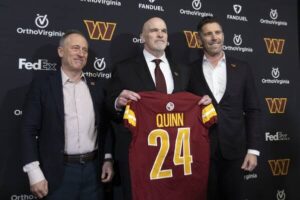
The Washington Commanders’ head coach found himself at odds with team management recently, leading to a highly publicized fallout. The tensions reportedly stemmed from disagreements over the team’s direction, coaching decisions, and the overall management of player personnel.
Sources close to the organization revealed that the coach had expressed frustrations with interference in coaching decisions by upper management. This included disagreements over player rotations, game strategies, and recruitment priorities. The clash escalated as both sides struggled to find common ground, with the coach feeling undermined and management asserting their authority over team operations.
Reports suggested that the strained relationship began to affect team morale and performance. Players were caught in the middle of the power struggle, unsure of which directives to follow amidst conflicting messages from coaching staff and management.
The situation garnered widespread media attention, with fans and analysts speculating about the implications for the team’s future. Many questioned the stability of the Commanders’ leadership and its potential impact on the upcoming season.
In response to the escalating tensions, team officials held discussions behind closed doors to address the rift and explore potential resolutions. However, the outcome remained uncertain as both sides stood firm on their respective positions.
The fallout underscored broader issues within the organization, raising concerns about leadership stability and the ability to foster a cohesive team environment. As the Commanders navigated through the controversy, the focus shifted from on-field performance to internal dynamics and the challenges of maintaining organizational unity amid discord at the top levels.